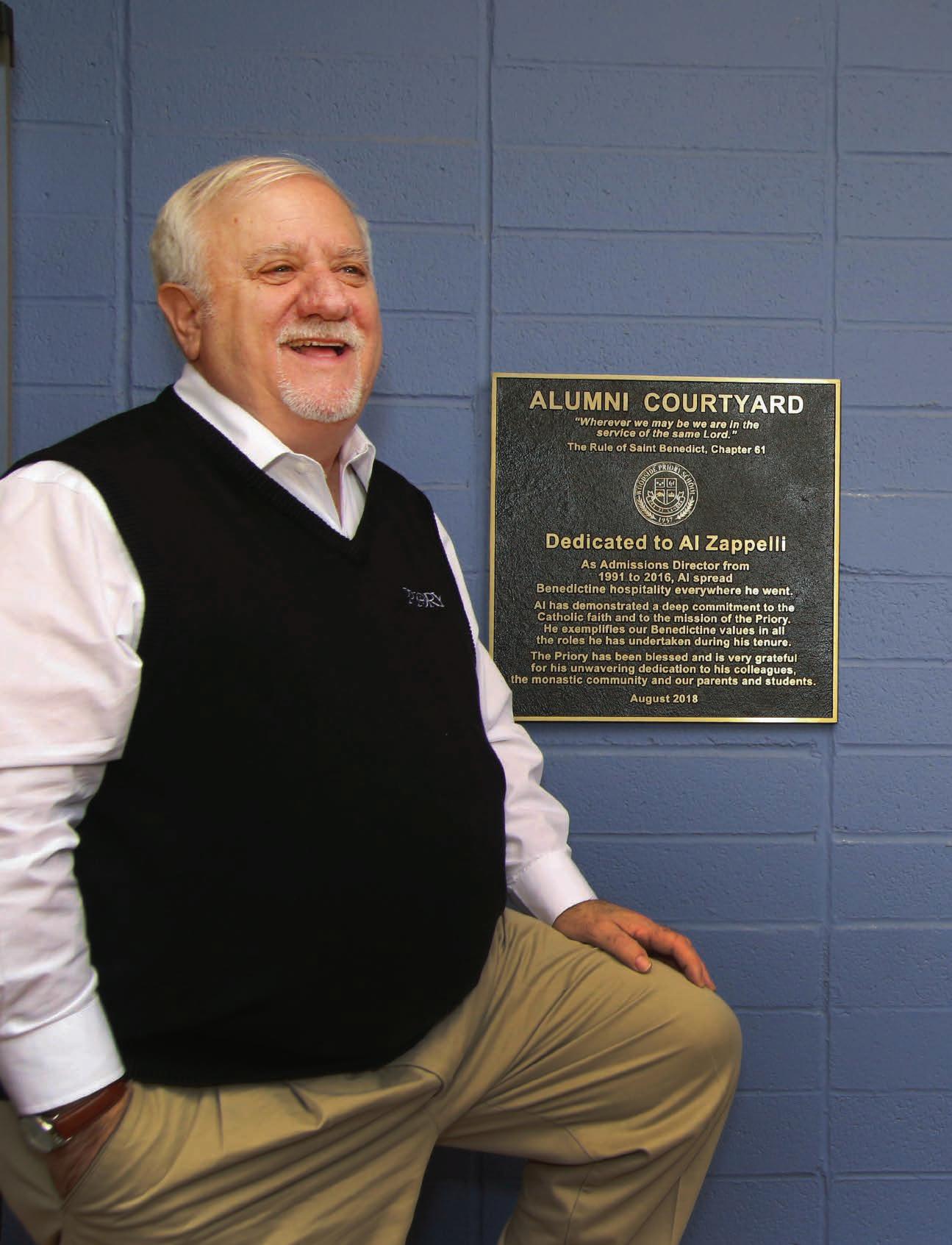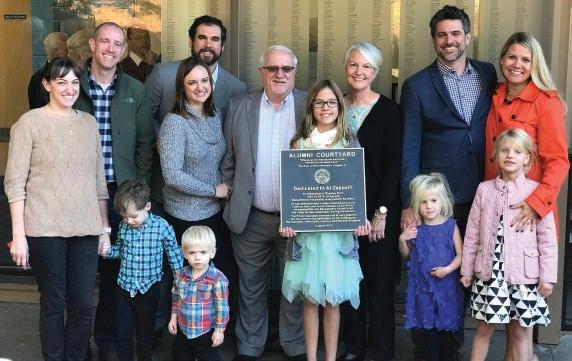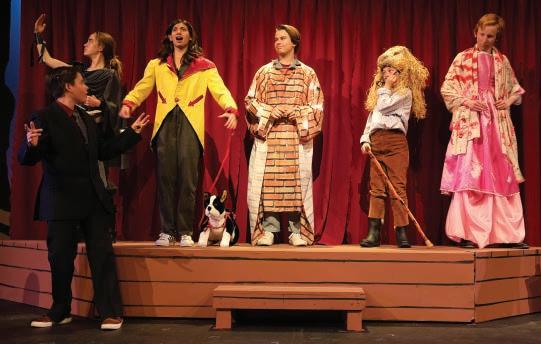
8 minute read
Farewell: Al Zappelli
Looking Back at the Al Zappelli
Priory History of Al Zappelli
by Thea Sullivan

It was 1990. George H. W. Bush was President, Nirvana’s Nevermind was climbing the charts, and a thousand miles apart, Al Zappelli and Priory—neither yet quite aware of the other’s existence nor the role each would play in the other’s future—were facing similarly uncertain moments.
It all had to do with babies. As in, not enough of them having been born the right number of years earlier in order to sustain enrollment at Catholic schools. It was a widespread crisis, and it meant that Al’s job in development at Gonzaga Prep in Spokane, Washington—a town he and his wife loved and where they thought they’d stay forever—had suddenly been cut, along with his entire department.
Meanwhile, in Portola Valley, Priory was experiencing the same enrollment challenges. In an attempt to increase its own declining enrollment, the historically all-boys school had made controversial plans to go co-ed. A core group, including some board members and Father William, who was Prior at the time, supported the move.
Al had grown up Catholic in the Bay Area, attended Bellarmine, and had a vague idea of Priory. “Its perceived reputation was as a boarding school for kids that couldn’t fit in anywhere else,” he says. He had lunch with a priest friend who told him, “It’s a great school. They know who they are, and the Benedictines are great educators. But I don’t know if the school is going to survive.” Still, jobs in Spokane were scarce and he and his wife Peggy, had a family of four children. So when Priory offered him the job of Admissions Director, despite the risk it entailed, he said yes.
From a numbers perspective alone, the job was daunting. Of Priory’s 106 enrolled students in the fall of 1990, over half were boarders. Between graduation and attrition, the school stood to retain only 60 students for the coming year. They would need 125 just to keep the
doors open. “That’s what I was walking into,” Al explains.
It wasn’t just a numbers problem. “The admissions office kept records in a spiral notebook,” Al says with a laugh. “There was no branding, there was no advertising. They didn’t even have something in the telephone directory. They had gone through a whole series of admissions directors. The person they had hired before me, with high hopes, had said, ‘No, I don’t want the job.’”
From his first day at Priory in October of 1990, Al hit the ground running. “We didn’t really speak at schools before I got here,” he says. “But I went to every feeder school I could. I put the message out to people, ‘I’m here, I will go wherever I can talk about the Priory.’”
He flew back to Spokane on weekends to see his family, who would eventually follow him down on Christmas Eve. “In a way it was nice not having the family here,” he says, “Because I would work here in the office, at my computer, until late in the evening.” But it was lonely, too, and sometimes he wondered if he’d made the right choice.
One night, he hit a low point. “I was here all by myself,” Al says. “I’d call home and Peggy’s trying to run the house up in Spokane with four young kids, and I remember hanging up the phone and walking down, and seeing Father Pius’ light on. And for some reason I went in to see him.”
Father Pius welcomed him in and offered him wine and cookies. “I said, ‘Father, I don’t know if this is going to work. I don’t know if I can bring my family down here.’ And he said to me, ‘You know, Al, the one thing we Benedictines believe in is hope. And unless you have hope, nothing’s going to work for you.’”
That was a defining moment for Al. From that point on, together with then-Dean of Students Tim Molak, and Academic Dean Brother Edward, and many others who believed in Priory, he just pushed forward. “You couldn’t step back and worry about it,” Al says. “In order to be a Catholic school,” he adds, “You have to have faith, hope, and love, according to St. Paul. And that was part of what Father Pius was telling me that day. So I felt together we could accomplish the goal.”
His hope and hard work paid off. Priory made its admissions quota that year—just barely, with fewer than 15 girls—and the school survived. Slowly, with the aid of Al’s leadership in admissions, Priory began to find solid ground. Enrollment grew, finances

stabilized, and within five to seven years, admissions became more selective. “At that point,” Al says, “It became much more about building a community.”
For the two decades that followed, Al’s work was focused on building and shaping the Priory community through the admissions process. “I made it a point to read every application,” he says. “So I was aware of every student.” Along with finding the right match between school and student, a sense of diplomacy and care was key. “If you’re truly Benedictine,” he explains, “You have to recognize the individuality of every family, every student. Even when a family departs, you hope you’ve provided some amount of dignity.”
Eventually, the Admissions department expanded to include Camille Yost and Carole Mauss, and Al was no longer alone in his office. “We were a team for about 18 years,” he says. “We complemented each other.” Whirlwind recruiting trips to Asia and elsewhere around the world followed, and between long flights, admissions fairs, and parent meetings,
Al cherished small moments of downtime, some with Father Martin, who was always a good sport. “One night we were walking through Kowloon, outside of Hong Kong,” Al remembers, “And Father Martin goes, ‘Hey look! Pizza!’ and points up to the second fl oor. And we go up there, and we had a great meal.” It felt good to relax together, he says, after days of non-stop admissions work. Al continued as Admissions Director at Priory for a total of 26 years. Three years ago, he transitioned to a brand-new role, Senior Director for Strategic Initiatives. Since then, he’s overseen planned giving, worked with Head of School Tim Molak on issues of Catholic identity, and networked with Benedictine schools around the world. He also managed Priory’s 60th anniversary, looking back over the school’s past just as he himself was refl ecting on his own long tenure here and preparing to move on. “It was fascinating diving into the history of this place,” he says. “There was the beginning of a classic college prep school by the founding monks of the 1960s and early 70’s, the affi liation with Saint Anselm’s that defi ned the later part of the 1970s, enrollment struggles in the 1980s, and the move to co-ed provided visions of a stable future of the 1990s began under Brother Joachim and a recommitted Board. Finally in a new century, a secure future emerged under the appointment of Tim Molak as Head of School.” What he doesn’t mention is his own important role in the school’s history, and in particular, the way his hope and hard work during a critically uncertain time helped the Priory become the thriving place it is today. Al will wrap up his career at Priory at the end of the current school year and move up to Novato where he and Peggy have bought a house. To honor him, the Board of Directors has established an endowed scholarship in his name, and Priory has dedicated the new Alumni courtyard jointly to Al and to the school’s alums, so many of whom he welcomed into Priory as brand-new students long ago. “I get to share that honor with them, which is really cool,” he says. “I don’t need a big dinner. My legacy are those names on the wall.” For Al, this, more than anything, defi nes his time here: the students he has welcomed in and their journeys through the school. “I will singularly miss Tuesday morning chapels,” he says. “Standing in the back of the chapel, looking out and saying, ‘I have watched the students go from 6th grade and move all the way to graduation. Thinking, and look what’s happened, lives have been transformed.’” Way back in 1990, both Al Zappelli and Priory were facing uncertain times. Today, thanks in part to his hard work, Priory is more solid than ever. Meanwhile, for Al, retirement presents its own kind of uncertainty. “I’m not sure what’s behind that door,” he admits, though he imagines it will include travel, more time with family, maybe some volunteer work in education. “Always we begin again,” he says with a smile.
The Zappelli family left to right: Anne Zappelli Reed, Stephen Zappelli, Jake Reed, Danny Reed, Julie Zappelli Noble, Tom Noble, Al Zappelli, Sawyer Zappelli, Peggy Zappelli, Lucia Zappelli, Jeff Zappelli, Elin Zappelli, Veronika Zappelli.

Al Zappelli Endowed Scholarship Fund
At the January 17th meeting of Priory’s Board of Trustees, Chair of the Board, Mike Calbert, announced Al Zappelli’s retirement from Priory effective June 30, 2019. Recognizing all that Al has given over the course of his 29 year career, Abbott Mark Cooper, O.S.B. established the Al Zappelli Endowed Scholarship Fund with a $50,000 gift from the Benedictine Directors. The endowed gift will be directed to fi nancial aid with a student will be named the Al Zappelli Endowed Scholar annually. Abbott Mark, said he hoped “to show some measure of appreciation for a man who has given himself heart and soul to the well-being of the hundreds of young men and women he has both encouraged and accepted, and who now call Priory their alma mater.” In recognition of his service to the school, the community is invited to honor Al with a gift to the Al Zappelli Endowed Scholarship Fund.








